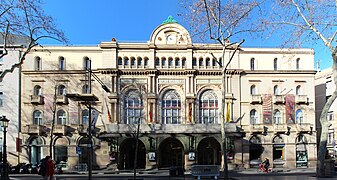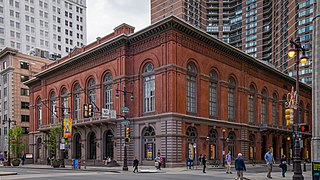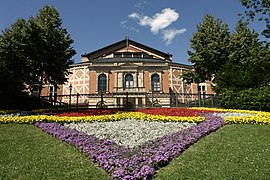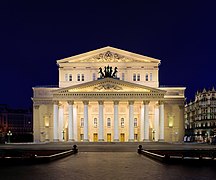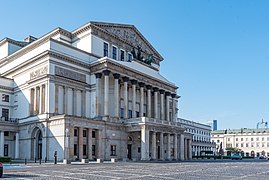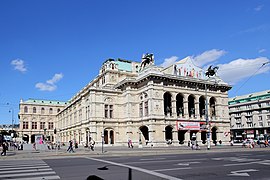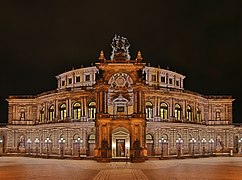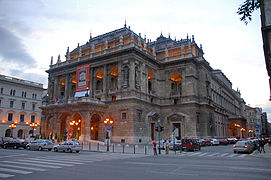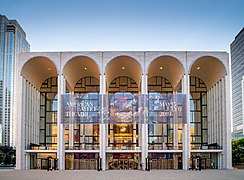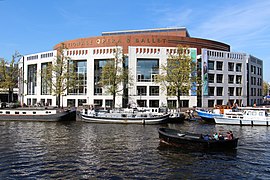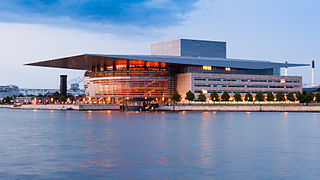Opera house


An opera house is a
While some venues are constructed specifically for operas, other opera houses are part of larger performing arts centers. Indeed, the term opera house is often used as a term of prestige for any large performing arts center.
History
Greco-Roman antiquity
Based on
Ancient theaters provided the ideal conditions, but it was not yet time for opera: the aim was to worship the deities, not to venerate the
Middle Ages
The Middle Ages saw the abandonment of ancient theaters, which were transformed into gigantic stone quarries, like many other ancient buildings, both public or private. Music still had its place in worship. It continued to bring audiences together, but its content was completely renewed. The Jeu de Daniel ("Play of Daniel") was a sung play, characteristic of the medieval Renaissance of the 12th century. The subject, taken from the biblical Book of Daniel, deals with Israel's captivity in Babylon.[4] The play was written and performed by students of the Episcopal School of Beauvais, located in northern France.[5] In the 15th century, sung theater of a religious nature found a special place in the mystery plays performed on cathedral squares. As before, they dealt with sacred subjects, but they were not about worship per se. Secular musical theater also existed, but had a more popular and intimate aspect (see, for example, Adam de la Halle's Jeu de Robin et Marion ("Play of Robin and Marion"), in the 13th century).[6][7]
Modern period
At the beginning of the 17th century, in Italy, singing underwent yet another renewal, with the emergence of
In the 17th and 18th centuries, opera houses were often financed by rulers, nobles, and wealthy people who used
Early United States opera houses served a variety of functions in towns and cities, hosting community dances, fairs, plays, and vaudeville shows as well as operas and other musical events. In the 2000s, most opera and theatre companies are supported by funds from a combination of government and institutional grants, ticket sales, and private donations.
-
Charles Louis Auguste Fouquet, duc de Belle-Isleduring the 18th century; it is the oldest opera house working in France.
-
The Estates Theatre in Prague (Czech Republic) is the only theatre left standing where Mozart performed.
-
The Academy of Music in Philadelphia is the oldest opera house in the USA.
-
The Bayreuth Festspielhaus in Bayreuth (Germany) was built by Richard Wagner and dedicated solely to the performance of his stage works.
Other uses of the term
In the 19th-century United States, many theaters were given the name "opera house", even ones where opera was seldom if ever performed. Opera was viewed as a more respectable art form than
Gallery
-
Teatro alla Scala in Milan, Italy
-
Berlin State Opera on Unter den Linden, Germany
-
Teatro Real in Madrid, Spain
-
Grand Theatre in Warsaw, Poland
-
Royal Theatre of La Monnaie in Brussels, Belgium
-
Royal Opera House in London, UK
-
Vienna State Opera in Austria
-
Palais Garnier in Paris, France
-
Semperoper in Dresden, Germany
-
Hungarian State Opera House in Budapest, Hungary
-
National Theatre in Prague, Czech Republic
-
Teatro Colón in Buenos Aires, Argentina
-
Zürich Opera House in Zürich, Switzerland
-
Theatro Municipal in São Paulo, Brazil
-
Opéra Nouvel in Lyon, France
-
Kennedy Center Opera House in Washington, D.C., USA
-
New National Theatre Tokyo in Tokyo, Japan
-
Copenhagen Opera House in Denmark
-
Oslo Opera House in Norway
See also
- List of opera houses
- List of opera festivals
- List of concert halls
- List of buildings
- Small-town opera house
References
Notes
- ^ Vitruvius, De architectura, Book V Chapter IV, Harmonic music according to the doctrine of Aritoxene, p. 223
- ^ Vitruvius, De architectura, Book V Chapter IV, Harmonic music according to the doctrine of Aritoxene, p. 243
- ^ Vitruvius, De architectura, Book V Chapter IV, Harmonic music according to the doctrine of Aritoxene, p. 286
- ^ Eugene, Enrico. "The Play of Daniel: European Music Series". Oklahoma: The University of Oklahoma. Retrieved 2009-11-18.
- ^ "The Play Of Daniel | Encyclopedia.com".
- ^ Hutchinson Encyclopedia (1988), p.10
- ISBN 978-1-84384-177-7. Retrieved 17 July 2012.
- ^ "Great Opera Houses of the World". BBC. Archived from the original on Feb 15, 2009.
Opera was always popular among ordinary people as well as among the rich, so that there was a large audience available.
- ^ Mancini, Franco; Povoledo, Elena; Muraro, Maria Teresa (1995). I Teatri del Veneto - Venezia. Vol. Tomo 1. Venice: Corbo e Fiore. pp. 97–149.
- ISBN 0-8214-1588-3.
The term 'opera house' is indeed misleading, and intentionally so; it provides a veneer of social and cultural respectability and avoids the stigma of the title 'theater.'
- ^ "The Name Opera House". Dramatic Mirror. March 7, 1885.
Sources
- Allison, John (ed.), Great Opera Houses of the World, supplement to Opera Magazine, London 2003
- Beauvert, Thierry, Opera Houses of the World, The Vendome Press, New York, 1995. ISBN 0-86565-978-8
- Beranek, Leo. ISBN 0-387-95524-0
- Hughes, Spike. Great Opera Houses; A Traveller's Guide to Their History and Traditions, London: Weidenfeld & Nicolson, 1956.
- Kaldor, Andras. ISBN 1-85149-363-8
- Lynn, Karyl Charna, ISBN 0-945465-81-5
- Lynn, Karyl Charna, Italian Opera Houses and Festivals, Lanham, Maryland: The Scarecrow Press, Inc., 2005. ISBN 0-8108-5359-0
- Plantamura, Carol, ISBN 0-8065-1842-1
- Sicca, Luigi Maria, "The management of opera houses: The Italian experience of the Enti Autonomi", Taylor & Francis, International Journal of Cultural Policy, 1997, ISSN 1028-6632



